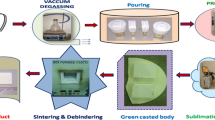Abstract
A new kind of nontoxic, water-soluble copolymer consisting of isobutylene and maleic anhydride was used to gelcast alumina ceramics at room temperature in air. The polymer acts as both a dispersant and a gelling agent. The influence of the polymer on zeta potential, rheological and gelling behavior of the alumina slurry was studied. Copolymers with a lower molecular weight had greater dispersing ability. Copolymers with a larger molecular weight had greater gelling ability. Alumina slurries with solids loading up to 58 vol% were prepared by adding copolymer (0.3 wt%, relative to the powder) with both short and long molecular chains. Increasing solids loading from 50 to 58 vol% decreased the linear shrinkage from 4.63% to 1.50% after drying, and from 14.51% to 13.18% after sintering, respectively. A solids loading of 56 vol% was associated with the highest flexural strength, as high as 534 MPa.








Similar content being viewed by others
References
T. Fujikawa and Y. Manabe: History and future prospects of HIP/CIP technology. J. Jpn. Soc. Powder Powder Metall. 50, 689–698 (2003).
I.Y. Prokhorov and G.Y. Akimov: Cold isostatic pressing as a method of pre-forming green ceramic ware. J. Eur. Ceram. Soc. 17(2), 129–131 (1997).
C. Tallon and G.V. Franks: Recent trends in shape forming from colloidal processing: A review. J. Ceram. Soc. Jpn. 119(1387), 147–160 (2011).
A.C. Young, O.O. Omatete, M.A. Janney, and P.A. Menchhofer: Gelcasting of alumina. J. Am. Ceram. Soc. 74(3), 612–618 (1991).
G.M. Buck and P. Vasquez: Ceramic slip casting technique. U.S. Patent No.5 266 252, 1993.
I.L. Denry: Recent advances in ceramics for dentistry. Crit. Rev. Oral Biol. Med. 7(2), 134–143 (1996).
X.J. Mao, S.Z. Shimai, M.J. Dong, and S.W. Wang: Gelcasting of alumina using epoxy resin as a gelling agent. J. Am. Ceram. Soc. 90(3), 986–988 (2007).
X.J. Mao, S.Z. Shimai, M.J. Dong, and S.W. Wang: Gelcasting and pressureless sintering of translucent alumina ceramics. J. Am. Ceram. Soc. 91(5), 1700–1702 (2008).
X.J. Mao, S.Z. Shimai, and S.W. Wang: Gelcasting of alumina foams consolidated by epoxy resin. J. Eur. Ceram. Soc. 28(1), 217–222 (2008).
O.O. Omatete, M.A. Janney, and R.A. Strehlow: Gelcasting—A new ceramic forming process. Am. Ceram. Soc. Bull. 70(10), 1641–1649 (1991).
L.G. Ma, Y. Huang, J.L. Yang, H.R. Le, and Y. Sun: Effect of plasticizer on the cracking of ceramic green bodies in gelcasting. J. Mater. Sci. 40(18), 4947–4949 (2005).
S. Maleksaeedi, M.H. Paydar, and J. Ma: Centrifugal gel casting: A combined process for the consolidation of homogenous and reliable ceramics. J. Am. Ceram. Soc. 93(2), 413–419 (2010).
Y. Yang, S.Z. Shimai, and S.W. Wang: Room-temperature gelcasting of alumina with a water-soluble copolymer. J. Mater. Res. 28(11), 1512–1516 (2013).
Y. Yang, S.Z. Shimai, Y. Sun, M.J. Dong, H.H. Kamiya, and S.W. Wang: Fabrication of porous Al2O3 ceramics by rapid gelation and mechanical foaming. J. Mater. Res. 28(15), 2012–2016 (2013).
S.Z. Shimai, Y. Yang, S.W. Wang, and H.H. Kamiya: Spontaneous gelcasting of translucent alumina ceramics. Opt. Mater. Express 3(8), 1000–1006 (2013).
A. Bleier and O.O. Omatete: Rheology and microstructure of concentrated zirconia-alumina suspensions for gelcasting composites. MRS Proc. 289, 109–115 (1992).
S. Maleksaeedi, M.H. Paydar, and J. Ma: Centrifugal deairing of concentrated ceramic slurries. J. Am. Ceram. Soc. 92(12), 2861–2869 (2009).
Acknowledgments
The authors would like to thank Kuraray Co. Ltd. and Kao Co. Ltd. of Japan for donating organic materials. The authors would like to thank Mr. Yoshihiro Yoshioka of Kuraray Polymer Co., Ltd., Japan, for his helpful discussion and donation of organic materials for this study. We also thank Prof. Hidehiro Kamiya from Tokyo University of Agriculture and Technology, Japan, for his helpful discussions.
Author information
Authors and Affiliations
Corresponding author
Rights and permissions
About this article
Cite this article
Sun, Y., Shimai, S., Peng, X. et al. A method for gelcasting high-strength alumina ceramics with low shrinkage. Journal of Materials Research 29, 247–251 (2014). https://doi.org/10.1557/jmr.2013.381
Received:
Accepted:
Published:
Issue Date:
DOI: https://doi.org/10.1557/jmr.2013.381




